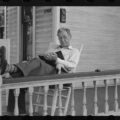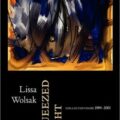“A Picture of Great Detail”: The Art of David Jones

The Orchard, Capel-y-ffin, by David Jones, 1920s
“And so I make for myself a picture of great detail,” said the great Homer scholar Milman Parry in a 1934 address to the Harvard Board of Overseers. Parry was explaining to his audience how the “historical method” in the humanities works in practice. The researcher gradually learns the rhythm of inquiry: how to keep out of and go into the past by turns until an image of the object of study begins to wriggle itself free from the blur of oblivion. This empirical process—Blake called it “sweet Science”—takes time and patience and a dash of something that Goethe once termed “tenderness.”

The Art of David Jones: Vision and Memory
by Ariane Bankes and Paul Hills
Paperback, £24.95
Lund Humpries, 2015
The English artist and poet David Jones possessed these qualities in abundance—almost to a fault—along with a streak of contrariety with respect to his own place in history. The Art of David Jones: Vision and Memory, which accompanies an exhibition now on view at Pallant House Gallery in Chichester, England, sets out to salvage Jones’s work from the relative neglect into which it has been falling since well before his death in 1974. The authors have assembled a selection of engravings, paintings, and calligraphy whose numinous delicacy is sure to catch the previously unacquainted eye. The images, large and sharp in reproduction here, are garlanded with catalogue copy of unusual informativeness. It all adds up to a picture of great detail. The running burden of the curators’ commentary is to establish the untimely, otherworldly quality of Jones’s imagination as a valid response to the upheavals of his age—and ours.
Jones’s unexpected achievement was to make art—an art—of historical method. The task wore Jones down during the decades following the First World War, in which he had served and was wounded in extended action as a private soldier. The pursuit of an answerable style taxed his mental health and may have cost him a reputation larger than he has yet found. Jones sought nothing less than to demonstrate—to, in his words, “show forth”—the interconnectedness of all things human, beastly, and angelic. The endpapers enveloping this volume excerpt a multicolored “map of the artist’s mind” that Jones, who had done a stint as an army cartographer, executed in 1943 in ink and graphite. This document details the cobweb of associative thinking that Jones dusted off for ever-new iterations over his lifetime, whether in prose, poetry, or paint. It winds through the meander known to medievalists as “the matter of Britain,” the labyrinth of legend floating around the figure of Arthur. Across a sheet of paper more than a foot-and-a-half square, Jones releases a shower of arrows pointing out the nodes of “myth + history + pseudo-history” that convoke, without confounding, the literary legacies of Greece, Rome, Scandinavia, Germany, Persia, Byzantium, Cornwall, Celtdom, and his father’s native Wales—all under the sign of the Cross.
Back home, demobilized after a spiritual awakening on the Western Front, Jones converted to Catholicism in 1921. The Mass, he discovered, made sense of everything. The Eucharist explained, without explaining away, even the trenches of the Somme, the setting of his first book, In Parenthesis, which won the Hawthornden Prize for 1938. In his acceptance speech for this award Jones said that in writing the book, an unclassifiable epic, he had “felt, more clearly than before, the unity of the Arts.” Both painter and poet confront the same set of problems.
At bottom, the job of the artist is to “make substantially and really present in one’s medium what already is” or, as he also put it, to “give a mode to that which exists modelessly.” For Jones, all art-making is of a piece with the ritual performed by Christ at the Last Supper, the subsequent events on Calvary, and every priestly oblation at the altar since. To Jones’s ear, the doctrine of the Real Presence rhymed with Post-Impressionist theories in the air at his London art schools before and after the war. Not representation but, as he emphatically hyphenated it, “re-presentation” of reality was the challenge laid down by both Church and Cézanne (himself a devout Catholic late in life).
Artists are therefore engaged in a perfectly gratuitous business. Their best efforts issue in uselessness. But the nonutilitarian, according to Jones’s aesthetic anthropology, is the one unmistakable mark of humanity as a whole. Only humans—and every last one of them, artist or philistine, wittingly or not—lift up, re-gift in gratitude what they have been endowed. This is the human prerogative: “the juxtaposition of ideas and shapes within a determined scheme, to so state the contingent as to display the necessary—an awareness of dissimilar threads of tradition and a conditioning of those traditions by our own contemporary sensitivity, the making of an object with its own way of behavior…” Mankind certainly has its work cut out for it, and all the items on its to-do list are supererogatory.
Vexilla Regis, a remarkable watercolor from the late 1940s that Jones priced prohibitively in order to keep close at hand, starkly poses the possibilities and problems of his style. It is, at a glance, just a picture of a wood. But a lingering gaze uncovers a welter of detail. A tangle of thorns rests at the base of the central tree, whose crown appears aureoled with light. Its trunk is studded with nails. The tree to its left supports a pelican’s nest in its branches, the one to the right an imperial eagle. Ponies wander through the grove. A curved Roman war-trumpet has been abandoned on the forest floor. When Jones did finally part with the painting he wrote a long letter to its new owner annotating its elements:
The general idea of the picture was also associated, in my mind, with the collapse of the Roman world. The three trees as it were left standing on Calvary—the various bits and pieces of classical ruins dotting the landscape—also older things, such as the stone henge or “druidic” circle a little to the right of the right-hand tree in the distance and then the Welsh hills more to the right again, the rushing ponies are, more or less, the horses of the Roman cavalry, turned to grass and gone wild and off to the hills…
Self-suffocating in its very prose-rhythms, Jones’s gloss is a last-ditch device to drive off the death of author. At the same time as he insists on his intentions, however, the author recuses himself from authoritative commentary: “I should like to make plain that none of this symbolism is meant to be at all rigid, but very fluid—I merely write down a few of the mixed ideas that got into this picture as you were kind enough to ask.” These ideas “were less explicitly intended than perhaps it sounds, when written down, and there is much other stuff besides.”
Jones wanted his work to mean to the viewer everything and more. Since Creation stands already self-sufficient, the artist only holds a candle in the sunshine. “Illustration” of the world only adds luster to all that is the case. Jones’s principle of inclusion is all-forgiving: “both/and” is the order of the day. This can and sometimes does eventuate in unreadably diffuse objets d’art. Of Vexilla Regis, Bankes and Hills admit: “In this one work Jones has brought together so many of his preoccupations that its central message threatens to be undermined by their profusion.” Only its “arching ambition,” they conclude, “rescues it from total obscurity.”
But what is Jones’s “central message” after all? Some notes he made around the time of his struggle with Vexilla Regis give a clue. Meditating on the deployment, in drawing, of a line or curve to impart a sense of volume to an object, Jones reminds himself that what may look on paper like a firm border, a non-negotiable boundary, is actually, or also, a provocation to pastures new, a point of departure. “This so-called ‘outline’ must never be thought of as an end or termination, it must be thought of, on the contrary, as expressing a continuation, i.e. it must express the uninterrupted continuation of the surfaces and planes from the front & side to the unseen surfaces & planes at the back. If you keep this very much in mind as you draw it should help at least to check this tendency of regarding the ‘outline’ as a kind of stopping place—which is the last thing it is. It is no more a stopping place than is the sea’s horizon. It is really all a question of feeling that truth intensely enough.” The “central message,” in short, lies at the periphery. Jones is a poet of the marches.
In one of his earliest paintings, the now-lost watercolor Wolf in the Snow of 1906, the eleven-year-old Jones places the eponymous predator at the edge of an icy forest, into which it peers with its tail between its legs. The composition of this scene bears an eerie resemblance to that of his oil The Garden Enclosed, made eighteen years later on the occasion of his engagement to Petra Gill. Here the female figure standing in for his fiancée pushes the male figure standing in for Jones almost out of the frame. Petra backed out of the bond before the wedding, and Jones would never marry. A repeated subject of Jones’s engravings over the next decade was the unicorn, associated since the Middle Ages with Christ. Jones’s creature takes up position on the shore of a pool and bends over to dip its horn into the waters, absorbing their impurities in an act of self-sacrifice. The unicorn is also an emblem of the artist, whose influence flows from the outside in.
Jones fostered a fierce devotion to marginalia even as he fought against it. The lines of his second published poem, The Anathemata (1952), blossom out of a thicket of footnotes creeping up from the bottom of every page. Likewise, his letter on Vexilla Regis is just another instance in his a lifelong attempt to intervene in the act of interpretation before, during, and after it has begun. His excuse for this intrusion is always to insist that the act itself is already overdetermined. The “epoch” or “civilizational situation” predisposes or “conditions” the reader’s response, as it does in fact the creator’s first move.
It is no surprise to Jones, therefore, that his writing bears an uncanny resemblance to that of Joyce or Pound or Wilfred Owen. It is less a question of “imitation” or “influence” in the vulgar sense than of the zeitgeist. The spirit of the age moves in mysterious but ineluctable ways. Footnotes, endnotes, and prose-paraphrases thus fulfill a double function. They sketch in for the benefit of the bewildered beholder the “unshared backgrounds” prerequisite to appreciation of the work, and they adumbrate an ultimate coinherence of all backgrounds sub specie aeternitatis. “Design” in both the humblest and the grandest sense, the “felicity of forms,” is what Jones understood as “my idea of a picture.” Happiness flooded him whenever he perceived forms to “assume significance” in juxtaposition with each other. Art for him is simply, and profoundly, a daily reminder that such joy is all around us just for the asking.
During the Second World War Jones began sending to friends, mainly as Christmas presents, black-and-white photographs of pieces of lettering laid out painstakingly in watercolor, his painted inscriptions. He called these calligraphic designs “my form of abstraction.” In their last chapter Bankes and Hills suggest an affinity between these inscriptions and “the folk art of embroidered samplers that were once hung in every Victorian home and every Welsh cottage,” because both “offer benediction.” Their comparison captures the homely beauty of Jones’s entire oeuvre. Jones was a prolific painter of the world from his window. Whenever possible he chose a room with a view, the higher the vantage point the better. Well after the war he would refer to his bedsit as a bunker. In many ways he never dug out of his first foxhole. It afforded him a hidden perspective on his century.
One example of his calligraphy, QUIA PER INCARNATI VERBI, is a perfect proof-text of the theological aesthetics informing the artist’s experiment with word as image. The theme is taken from the Preface for Christmas in the old Latin liturgy. In translation: “For by the mystery of the Word made flesh the light of thy glory has shone anew upon the eyes of our mind.” In his first treatment, finished in 1945, Jones enjambs the word “INCARNATI” perversely, inserting the line break between the “C” and the “A.” This has the effect of forcing the reader to become, at least for a frantic moment, an uncomprehending looker, precisely so that the mystery of Incarnation might “shine anew” on the mind’s eye. A few years later the line breaks are different, and the color-scheme, too. On the second take “VERBI” alone is allowed rubrication. Every inscription, according to the authors, “involved a fresh meditative act.” Every encounter with one of them is an experience akin to prayer. The letters, and their physical and metaphysical relationships to each other, are as susceptible to adjustment by the eye as they were to the hand of Jones, who worked out their position in pencil over an opaque pigment called Chinese white. Nothing about them feels final. Even the barely noticeable curve along the top of one inscription is there to induce an optical correction, a two-dimensional counterpart in paint to the entasis of a Greek column.
Jones would often inscribe on the back of these postcards a personal message to their intended recipient, another set of marginalia, giving his sources, an English crib of the Latin, Greek, Welsh, or Anglo-Saxon, and tossing in a typically idiosyncratic gloss on the meaning of the whole. But this was, he said, a “living lettering.” His part in its production remained one of pure hypothesis and conjecture. Artists merely serve as secretaries to the Author in Eternity.
About Thomas Berenato
Thomas Berenato is a PhD candidate in English at the University of Virginia and the co-editor of the Unpublished Writings of David Jones forthcoming from Bloomsbury Academic.






